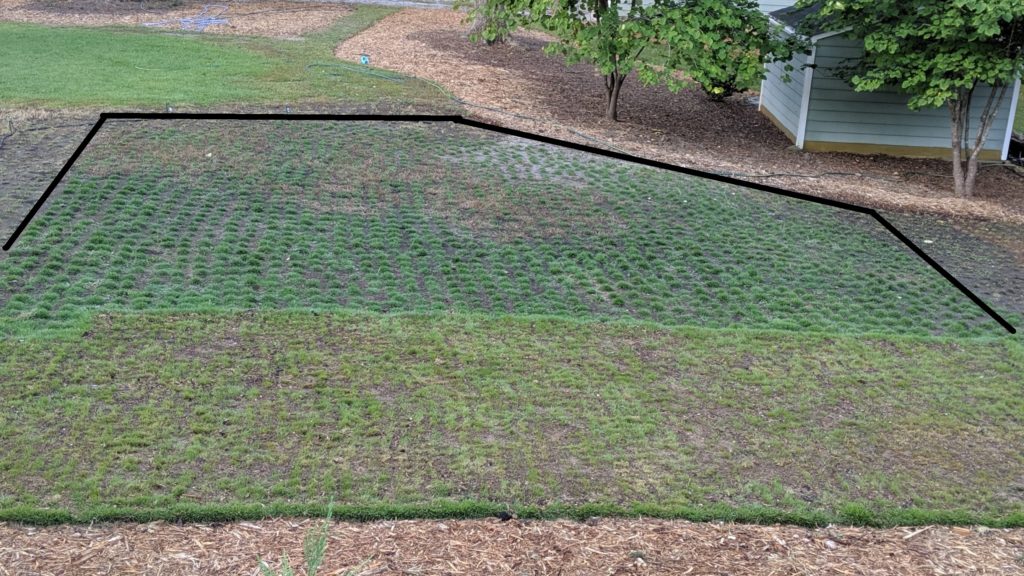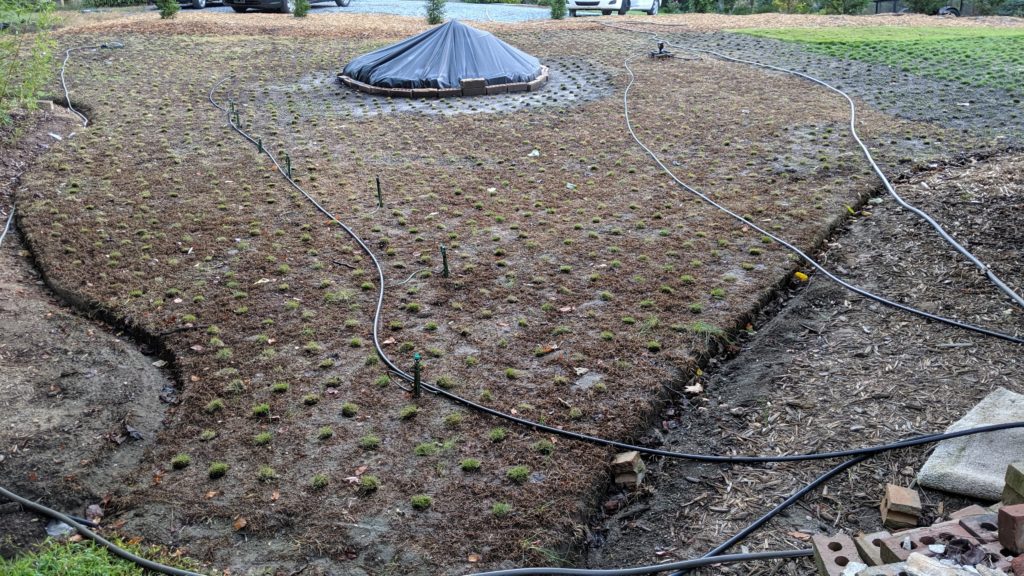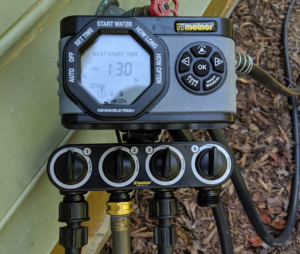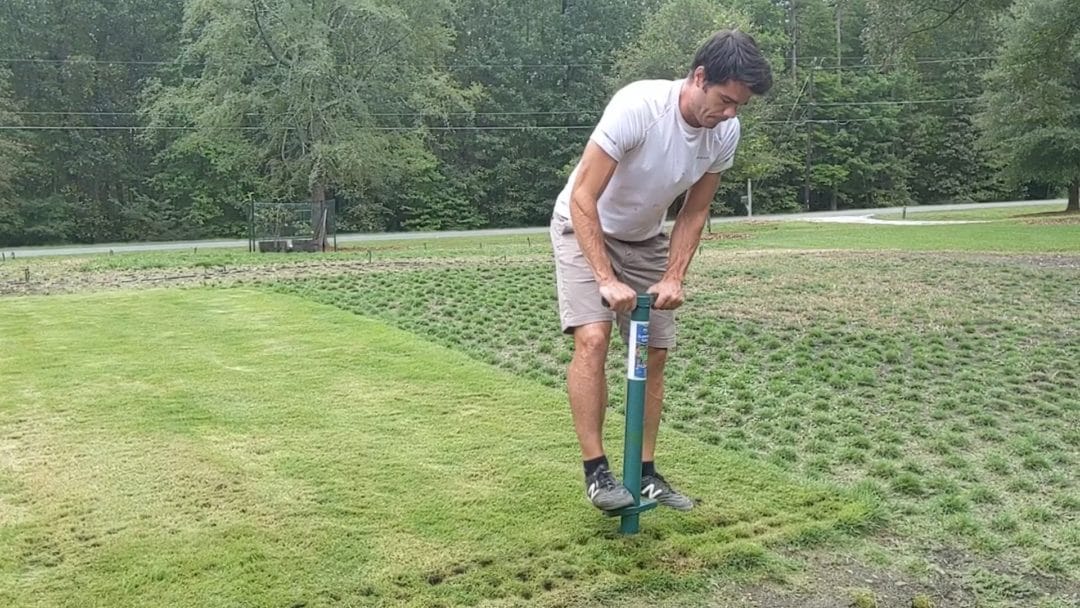Introduction: Some additional information to Planting grass plugs with sod. This includes herbicide use, watering, and a few other items.
Watering new plugs
Consider the area that your sprinklers will cover before planting sod or plugs
- The picture below shows is a nice square planting zone that can be totally covered by one sprinkler

- You can set the sprinkler to a timer and not have to touch it again
Sometimes you will have to plug around odd areas of your lawn

- Here I have set up 2 sprinklers, and 1 line with micro-sprinklers attached to drip line irrigation
- Then I used a multi-zone timer to so I can control all 3 sections easily

- You don’t have to use drip line irrigation
- I could have used a sprinkler. There would just be some over spray into the woods
Weed control
By Hand
- If the area you plugged is small and you have the time, you can pull up weeds by hand
- Most weeds will pop up during the 1st month after plugging, because you are watering the area so much
- At that time the weeds will be small and the soil will be wet so they aren’t too hard to pull up
Pre-emergent herbicides
- Pre-emergent herbicides work by preventing weed seeds from germinating
- Ronstar is the only pre-emergent herbicide that you should use on new plugs
- Other pre-emergents can prune new roots which isn’t great for new plugs
- If you apply it shortly before plugging, it does a great job preventing weed seeds from germinating
- It is a little expensive, makes a big difference
Post-emergent herbicides
- These work by killing weeds that have already sprouted
- The herbicide you use depends on the weeds that are growing
- I will give you examples of the weeds I commonly see when plugging Zoysia, and the herbicides I use
- Crabgrass → Quinclorac
- Crabgrass is by far the most common weed I deal with. I keep some Quinclorac with the emulsifier they recommend mixed up in a bottle. I will usually need to spot spray 2-4 weeks after plugging. Thereafter they will come up less often, because the area is dryer, but I may need to spray some spots once a month. I have been very impressed with Quinclorac in killing even very established crabgrass.
- A multitude of broadleaf weeds including wild Garlic, wild onion, dandelion, clover, and plantains. → Southern Ag Lawn Weed Killer with Trimec (2, 4-D + dicamba + mecoprop)
- Wild Bermuda → Fusilade II + Turflon Ester
- Bermuda is a tough weed to kill in zoysia lawns without harming the zoysia. Fusilade II works the best for this. There is a study that showed that adding Turflon caused less harm to the zoysia than fusilade alone. So, I combine them.
- Sedge weeds → Sedgehammer
- Crabgrass → Quinclorac
- When plugs are young you can often times spot spray the weed, while missing the plugs
- You can visit the following link (and many other sites) for more information on herbicides with particular grasses:
Always read the label on weed killers
- They are very wordy, but they have important information like…
- Adding a surfactant for better performance
- Not spraying during the heat of the day
- How long you need to wait before watering
- How long you need to wait before mowing
- Be especially careful to water plugs according to your schedule when you are applying herbicides
- Water will help your grass bounce back from herbicides
Don’t stress out too much
- When you first plant your plugs they will probably look pretty grey and dead for the first few weeks
- It will probably take a month before they start looking really good
- I have made plenty of mistakes by not watering enough or by letting weeds grow to where you couldn’t even see plugs
- When these things happen it usually slows down the plugs from optimal growth but they don’t die
- Once you get things back under control they can go back to optimal growth
Start by plugging small sections at a time
- I wouldn’t recommend trying to plug more than 1,000 sq ft in a day
- Even that can be difficult if you soil is too dry, or it is your first time plugging
- There is no harm in starting with maybe 500 sq ft at first, and then doing more when you get the hang of it
Start by planting a small area of sod
- One pallet of sod (usually ~450 sq ft) can be used to plug 1,200 sq ft easily
- 6 weeks later, it will be ready to plug again
- This time and thereafter since the sod is more firmly established you can plug closer to 1,600 sq ft.
- Plugging 1,600 sq ft every 6 weeks, while maintaining watering and weed control is a decent amount of work. Particularly if you are new to it
- Once you get the hang of the process it does become a lot easier. At that point you can always buy more sod if you want to move at a quicker pace
Sharpening the end of your plugger
- The end of the plugger comes slightly sharpened from our factory
- We don’t sharpen it too much or it will likely bend if you hit rocks
- You can sharpen it more yourself, but you will usually only see benefits from that if you are plugging through very dense grasses
- Like Emerald Zoysia for example, or any grass where a thick layer of thatch has developed
- It will most likely bend as you plug if you hit rocks, and then you will need to resharpen it
- To sharpen the end of the plugger you can use various instruments
- A file
- Various grinding bits on an electric drill, dremel tool, or pneumatic drill.
- Bench grinder
- Belt sander
- We sharpen the outside diameter of the tube in the factory, but you can sharpen the inside or outside of the tube

